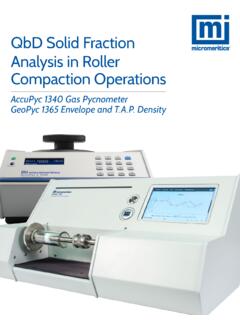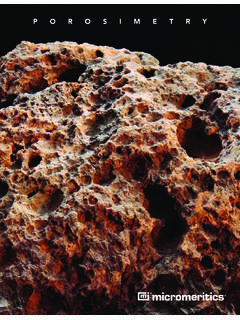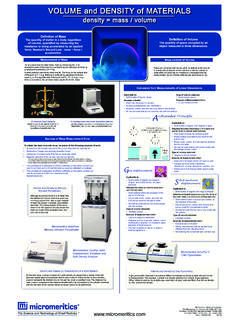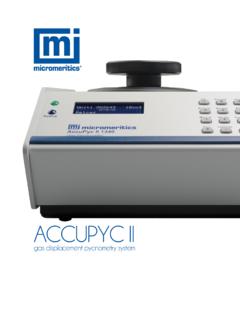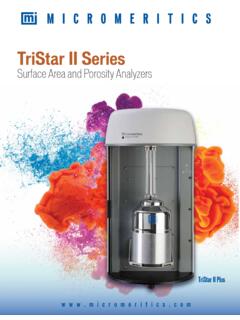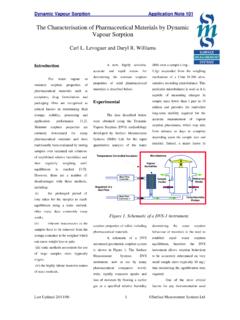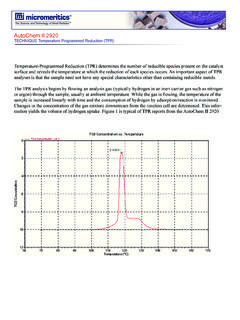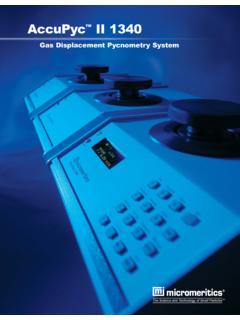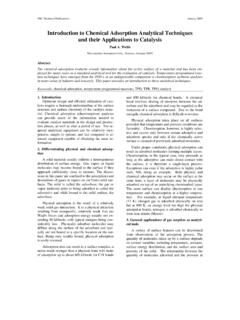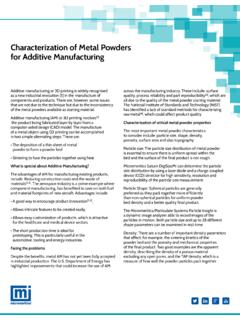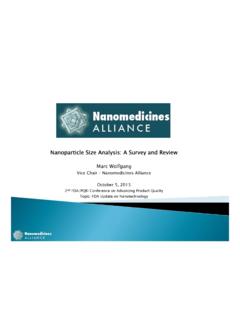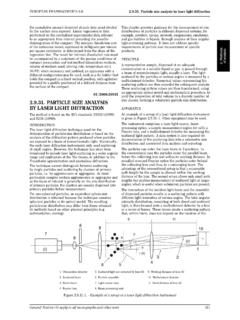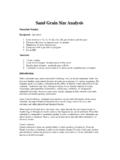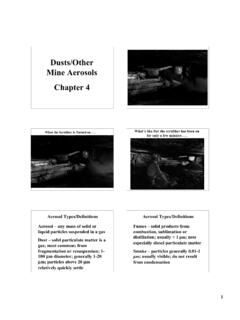Transcription of DENSITY ANALYSIS APPLICATIONS - Micromeritics
1 One Micromeritics Drive, Norcross, GA 30093-1877, Sales (770) 662-3633, International Sales (770) 662-3660 Customer Orders (770) 662-3636, Fax: (770) 662-3696 Internet Web Site: SETTING THE PACE is approaching a half-century of experience inproviding innovative products to the particle technology developed by Micromeritics has been the recipient ofawards for design excellence on numerous occasions. Our instrumentshave been chosen as the standard of performance by many multi-national corporations. As a result of this, Micromeritics is pleased toprovide products and product support to customers around the driving force of our Company is to develop and support high-quality, high-performance instrumentation of unmatched accuracy andutility, never losing sight of the primary importance of satisfying theneeds of our maintains a high level of interest in the needs of the many industries it serves and aggressively responds to these needs.
2 It isthis response that firmly establishes Micromeritics as one of the world sleading suppliers of particle technology ANALYSISAPPLICATIONSC arbon blackCarbon clothCatalystsCementCeramicClayCoating powderCokeDolomiteFilmFoamGraphiteIron oxideKaolinLactoseLimestoneMetal partsNickelPigmentPolyester fiberQuartzResinsSilicaStarchTa l cTungsten carbideZeoliteZinc oxideA partial list of materials thatutilize DENSITY determinationReducing the weight of some products is often desirable for performance aswell as economic reasons. Many manufacturers strive to develop materialsthat are partially porous yet still fulfill their function. DENSITY measurementsplay a key role in these developments. In other products, preventing porosity is important. Closed air bubbles (cells) are desirable in home-insulating materials,but an open cellular structure is required for automobile and furnace thus keep a check on closed and open cells by DENSITY evaluation.
3 A noted decrease in DENSITY from a reference value can indicate a void withinthe product, an undesirable situation for some manufactured products such asthose composed of laminates. An increase in DENSITY may indicate a process isoptimized. For example, the DENSITY of a polymer increases as it approaches itscrystalline number of industries that depend on DENSITY determination is extensive. In the agricultural industry, the DENSITY of grains, feeds, tobacco, fertilizer,insecticides, and soil samples are measured. The ceramic industry uses densityand specific gravity measurements on ceramic whiteware materials. In thepharmaceutical industry, DENSITY measurements are correlated with solubilityrates of powders and tablets. The production of construction materials such as insulation, bricks, and tiles requires the determination of absolute manufacture of carbon and graphite materials requires bulk densitymeasurements.
4 Studying the reaction rate of porous catalysts is augmented by measurements of particle DENSITY and volume. Other industries that benefitfrom DENSITY measurement include plastics, glass, powder metallurgy, paint,textile, and pulp and raw material to finished product, DENSITY measurements support a widevariety of industrial needs. Micromeritics experience in the field of densitymeasurement began in 1961, when we introduced our first hand-operated heliumpycnometer. In 1981 we developed the first commercial automatic gas pycnome-ter. Today, Micromeritics is a leading provider of instruments that determinedensity. We support these products with a worldwide network of personneltrained in APPLICATIONS and service support. Our pycnometers deliver fast,accurate, and reliable measurements to determine absolute, envelope, and bulkdensity measurements.
5 Micromeritics has over 50 sales, service, and distribution offices throughout the DENSITYA bsolute DENSITY (also termed the true, real, apparent, or skeletal DENSITY ) isobtained when the volume measured excludes the pores as well as the void spacesbetween particles within the bulk sample. Until recently absolute DENSITY wasdetermined using water or another liquid which was expected to fill the pores inthe sample, thus removing their volume from the measurement. Sometimes thematerial was subjected to boiling in a liquid to ensure pore penetration and some-times the sample was evacuated prior to immersion to assist pore filling. However,surface tension effects and entrapped gases resisted the filling of very small offers helium (or other gas) pycnometers that are much moreaccurate and easier to use.
6 They are faster than liquid-based techniques becausegases easily, quickly, and thoroughly fill the minutest pore spaces. The absolutedensity determined by helium pycnometry is being ever more frequently referred tosimply as the helium DENSITY . ENVELOPE DENSITYE nvelope DENSITY (sometimes called the bulk DENSITY ) is determined for porous materials when pore spaces within the material particles are included in the volume measurement. The Micromeritics envelope DENSITY analyzer uses a free-flowing dry powder as the displaced medium. The material to be tested issurrounded by this medium that does not penetrate pores but conforms to irregular surface contours to form a tight-fitting envelope. This dry powder medium permits rapid, easy-to-make DENSITY measurements without damaging or contaminating the sample.
7 Envelope DENSITY values are less than absolutedensities when the material is porous; values for absolute and envelope DENSITY are equal for nonporous materials. Total porosity can be calculated from a measure of both absolute and envelope DENSITY on the same material. Micromeriticsoffers pycnometry instruments that can rapidly measure the envelope DENSITY of porous objects of irregular size and (TAP) DENSITYThe DENSITY obtained from filling a container with the sample material and vibrating it to obtain near optimum packing is also called bulk DENSITY by frequently is referred to as tap DENSITY because it has traditionally beenmeasured by mechanical devices that lift then drop the container, producing a loud tapping noise. Such a measurement is of great interest in packing and shipping items like breakfast cereal and other bulky products.
8 Tap DENSITY is not an inherent property of a material but depends on particle size distribution and shape as well as measurement techniques. Since interparticle voids are included in the measurement, tap DENSITY is always a lesser value than envelope DENSITY . Micromeritics provides instruments which have the ability to obtain precise results comparable to traditional tap DENSITY measurements. They are ideal forobtaining the packing densities of powder and bulk gas pycnometers are being used worldwide to obtainmaterial DENSITY measurements. These measurements are neces-sary in the manufacture of many of today s products. Simply defined as massdivided by volume (g/cm3), DENSITY measurements guide the formulation processand influence the overall quality of manufactured the volume of a rigid, solid material of simple geometry is straight-forward.
9 However, measuring the volume of a material with an irregular shapepresents a challenge. Archimedes succeeded in measuring the DENSITY of KingHiero II s crown by immersing it in water and measuring the volume of waterdisplaced. This technique, now known as pycnometry, is still appropriate fornonporous objects and, with variations, for porous objects. Now, however, the displaced medium may be a gas, liquid, or fine materials have within their structure pores made up of cracks, crevices,and tortuous passageways. This leads to three different definitions of DENSITY ,each requiring different techniques for measurement. The first type of DENSITY measurement determines only the solid volume of the sample material (byexcluding the open pores and voids within the material), while the seconddetermines the DENSITY of the sample as defined to include the open and closedpore spaces within.
10 The third definition of DENSITY defines sample volume interms of the volume of a container into which a quantity of material composedof multiple pieces can be placed. This measurement includes not only the porespaces within each piece but also the spaces among the pieces and requires astill different technique of over 37 years, Micromeritics has dramatically improved boththe speed and accuracy of DENSITY measurements. Our pycnometers are based on proven techniques anddeliver consistent and reliablemeasurements. By providinginnovative technology fordetermining absolute, envelope, and bulk DENSITY , Micromeritics is playing anessential role in meeting industrial DEFINEDB ritish Standards Institution definitions of densityAbsolute powder DENSITY - The mass of powder per unit of absolute powder powder DENSITY - The mass of a powder divided by its apparent powder volume- The volume occupied by a powder excluding all pores and DENSITY - The mass of a particle divided by its volume, excluding open and closed volume- The external volume of a particle, powder.
